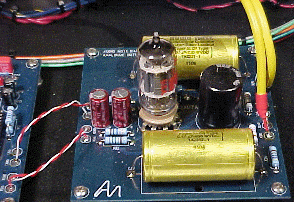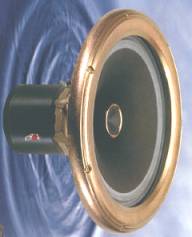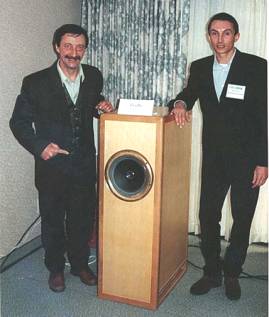|
|
Tip #15
CES and THE SHOW 2000
January 6 -9, 2000, Las Vegas, Nevada
By Dick Olsher
The creme de la creme of high-end audio was on display in Las Vegas. The following are merely excerpts from my complete Show Reports published at Enjoy the Music.com Review Magazine (www.enjoythemusic.com/magazine). I spent a frantic four days attempting to cover both the Consumer Electronics Show's high-end exhibits at the Alexis Park Hotel as well as "The Home Entertainment Show" (THE Show) at the St. Tropez, a mere half block from the Alexis Park. My goals were to focus on new and innovative technology and to identify industry trends. It does my heart good to report that in addition to digital innovation, we are entering the new millenium with old technology such as tubes, horns and full-range speakers very much alive, healthy and kicking.
The Digital Wars
It is ironic that Sony, the folks that introduced the first CD player in the US some 18 years ago with the promise of perfect sound forever, are now touting the super audio CD format (SACD) as a means to expand the high-end market. Sony recently introduced the SCD-777ES, its second SACD player, which incorporates most of the key technologies of the Sony reference standard, the SCD-1, at a US retail price of $3,500. Philips and Marantz also announced plans to introduce SACD to the USA in the second quarter of 2000. While Marantz is targeting the high-end market, Philips is targeting a more affordable price point with a SACD player that includes DVD-Video.
The Sony player is able to read the three disc variations associated with the SACD format: a single high-density layer disc; a disc with dual high-density layers for increased recording time, and a hybrid disc that combines a high-density layer and a standard-density (CD) layer. Of course, all standard CD and SACD players will be able to play the hybrid disc. I believe that this is a critical compatibility issue. Ensuring that the standard CD as well as the hybrid CD is compatible with any existing CD player, will give SACD viability in the market place. Although I tend to agree with Telarc's Robert Wood, who is quoted as saying that SACD represents a staggering improvement over what we have now, the public at large has not been complaining about and clamoring for better CD audio quality. The hybrid CD, at least has a chance of being stocked by mainstream music stores, as it can be played on any of the over 600 million CD players out there, yet has the added value of SACD sound capability. Philips also seems to think so, as they are gearing up hybrid disc production next month, with full production slated for the second quarter of this year at the Sonopress factory in Europe.
The Accuphase Laboratory is scheduled to release its model DP-100 SACD transport this spring. An optional High-Speed Link board will provide a flexible interface capable of accommodating any digital source: SACD (1bit/2.8224 MHz), DVD-Audio (24bit/192 kHz, 24bit/ 96 kHz), and conventional digital standards such as CD, MD and DAT. A matching processor will also be introduced. The DP-100 will also be compatible with the new DP-75V CD player via the HS-Link. 
The Accuphase DP-75V is a new generation CD player that uses six 24-bit Delta-Sigma converters per channel in parallel for ultra low distortion and state-of-the-art resolution. For the ultimate in analog and digital integration, you should seriously check out the DC-330 - the world's first SACD and DVD-Audio ready digital preamp. It offers a wide range of digital and analog input and output boards to allow the user to meet any conceivable digital and analog needs. E-mail info@axiss-usa.com for more information.
An exciting development at the other extreme of the price range is the Perpetual Technologies P-3A DAC. It is priced at $599 and will be available in March - direct to the consumer - at www.perpetualtechnologies.com. The P-3A is said to use the latest Crystal SemiConductor CS4397 chipset, a high-performance 24-bit 44.1/48/96/192 kHz stereo DAC. The output stage is built around a Burr-Brown op-amp operated in class A. According to president Mark L. Schifter, the P-3A represents the best affordable DAC made and he believes that it should compare favorably to units costing $3,000 or $4,000. The Perpetual Technologies P-1A ($950) is an affordable DSP-based correction engine, which in its basic form upgrades the sound of standard CDs to 24-bit/96 kHz resolution by combining a software-based interpolation scheme with hardware-based upsampling. Software upgrades allow more functionality by implementing specific speaker and room corrections.
Audio Note UK is creating quite a stir with their Direct from Disc (tm) 1xoversampling(tm) circuit. The name is an intentional oxymoron, and is meant to highlight the fact that their DAC does NOT use a digital filter with oversampling. The claim is that the oversampling, digital filtering and noise shaping everyone is using in their converters hurts sound quality, and according to Audio Note is a major stumbling block for standard 16-bit CD sound. The briefest of auditions convinced me that there is something to this. 
Here's a hot tip: check out Audio Note's new DAC 1.1 kit, which at US$699 promises to become a true giant killer (http://www.audionote.on.ca/)
Be sure to read Steve Rochlin's review at Enjoy the Music.com.
The Renaissance of the Full-Range Driver
In what appears to be a belated resurgence of the full-range driver, several companies showcased minimalist speakers. By that I mean designs that use a single driver over a wide bandwidth, often over the range from 100 Hz to 10 kHz, and usually (but not always) with help from a super tweeter or subwoofer at the frequency extremes. The popularity of the format stems from the realization by a wider audience that even expensive multi-way speakers lack the coherency and dynamics of a good full-range.
It was about this time that I realized that I might just be was allergic to 1-inch dome tweeters. It seems to me that so many designers these days push such tweeters outside their comfort zone, down to 2 kHz or even lower. The motivation is to better integrate the upper midrange transition from mid/woofer and to maintain better dispersion around the crossover. But there is a price to pay. Even though the tweeter might be able to safely sink power over its bandwidth, the distortion spectrum rises significantly when it is hit hard below say 3 kHz. I typically hear compression and harshness creep in with so many modern designs that I'm nervous about sitting down in front of any loudspeaker featuring a 1-inch dome. It may be that many audiophiles are insensitive or even prefer a bright and "lively" (in other words: harsh and edgy) upper midrange. For me, however, it's a kiss of death.
Free from the compromise inherent in crossing over a tweeter anywhere in the midrange, full-range drivers tend to reproduce the entire mid band with much greater dynamics, coherency, and far less distortion. That's not to say that full-range drivers don't encounter problems in this range. Problems arise when such drivers are used in folded horns where reflections and resonances are created, especially in the throat of the horn. In addition, many of these drivers are literally paper-thin and are prone to breakup in the presence region with attendant harshness. To be successful, a full-range driver design needs to address such issues with the greatest of care.
This appears to be the case with the ReTHM loudspeaker (Sanskrit for harmony) fr om Vector Research (Tel.: 213-624-6908; e-mail: anilverma@earthlink.net), designed by Jacob George. The enclosure has been designed to eliminate back-wave reflections that might impact the driver. The geometry of the enclosure aids in minimizing standing waves and baffle diffraction effects. In addition, the Lowther DX-4 driver has been modified by the addition of a floating paper cone just outside the whizzer cone to quiet presence region resonances. Driven by the Diva Seduction amplifier ($2,800), the ReTHM sounded absolutely delicious with a nice blend of delicacy and dynamics. Information about Diva Classic Audio may be had at: http://web.singnet.com.sg/~seahss. om Vector Research (Tel.: 213-624-6908; e-mail: anilverma@earthlink.net), designed by Jacob George. The enclosure has been designed to eliminate back-wave reflections that might impact the driver. The geometry of the enclosure aids in minimizing standing waves and baffle diffraction effects. In addition, the Lowther DX-4 driver has been modified by the addition of a floating paper cone just outside the whizzer cone to quiet presence region resonances. Driven by the Diva Seduction amplifier ($2,800), the ReTHM sounded absolutely delicious with a nice blend of delicacy and dynamics. Information about Diva Classic Audio may be had at: http://web.singnet.com.sg/~seahss.
Loth-X (www.lothx.com) has also made a serious investment in full-range driver technology with the Stamm driver, a tri-cone design featuring three paper cones driven by a single lightweight voice coil. The paper cones are coated with a resin, which incorporates an anti-fungal compound, protecting the driver from deterioration in humid tropical climates. Hence, Loth-X speakers come with a 20-year warranty. High-flux density Alnico magnets are used to generate an efficiency in excess of 100 dB. The Stamm driver is typically used in conjunction with a back-loaded horn. In particular, I liked the Loth-X Azimuth, which is rated at a sensitivity of 104 db and is intended for low-power, single-ended triode applications.
Dennis Pawlik of Apex (Tel.: 415-897-5616) is the French Connection - the US and Canadian distributor of J.C. Verdier, PHY-HP, and Ocellia loudspeakers by Acoustique & Lutherie. The J. C. Verdier line is relatively well known in the US, esp ecially for its innovative turntable designs. The other two lines clearly deserve wider recognition. Let's start with PHY-HP (Haute parleurs), a manufacturer of full-range drivers, as well as a tweeter and cable. The designer, Mr. Salabert, takes great pride in his hand-crafted manufacturing process, as each driver is quality controlled from start to finish to very close tolerances. Matched pairs of woofers are selected after a considerable break-in period and are matched to a tolerance of 0.1 gram on moving mass, 0.1 ohm on DC resistance, and 1 Hz on resonant frequency. The drivers carry a lifetime guarantee to the first owner. Shown here is the KM-30 coaxial driver with truly coincident acoustic centers. The main cone covers the range from 45 Hz to about 10 kHz. The TW-37 piezo electric tweeter takes over at 11 kHz and is flat to 30 kHz. Note the stunning bronze basket. The magnetic system features mild steel pole pieces with an Alnico magnet. Sensitivity is 97 dB with a nominal impedance of 16 ohms. ecially for its innovative turntable designs. The other two lines clearly deserve wider recognition. Let's start with PHY-HP (Haute parleurs), a manufacturer of full-range drivers, as well as a tweeter and cable. The designer, Mr. Salabert, takes great pride in his hand-crafted manufacturing process, as each driver is quality controlled from start to finish to very close tolerances. Matched pairs of woofers are selected after a considerable break-in period and are matched to a tolerance of 0.1 gram on moving mass, 0.1 ohm on DC resistance, and 1 Hz on resonant frequency. The drivers carry a lifetime guarantee to the first owner. Shown here is the KM-30 coaxial driver with truly coincident acoustic centers. The main cone covers the range from 45 Hz to about 10 kHz. The TW-37 piezo electric tweeter takes over at 11 kHz and is flat to 30 kHz. Note the stunning bronze basket. The magnetic system features mild steel pole pieces with an Alnico magnet. Sensitivity is 97 dB with a nominal impedance of 16 ohms.
The Ocellia line of speakers features the PHY-HP full-range drivers. But there's more t o the story. Flying in the face of conventional wisdom and practice, Ocellia systematically uses thin-walled cabinets. Construction techniques that rely on mass-loading, bracing, and damping are rejected on the basis that they can never entirely eliminate vibrational energy, and that such methods produce residual narrow-band, slowly decaying cabinet modes that smears musical detail. Instead, Ocellia's Samuel Furon (on right, with Mr. Salabert of PHY-HP) seeks to treat the cabinet much like a musical instrument. The frame is made of strips of solid beech wood, dovetailed together, while the panels much like a violin soundboard are made of spruce. The panels are of differing thicknesses and are allowed to vibrate independently. The idea is to achieve a balanced acoustic output that has a very quick time signature. I can testify that the end result is quite musical. o the story. Flying in the face of conventional wisdom and practice, Ocellia systematically uses thin-walled cabinets. Construction techniques that rely on mass-loading, bracing, and damping are rejected on the basis that they can never entirely eliminate vibrational energy, and that such methods produce residual narrow-band, slowly decaying cabinet modes that smears musical detail. Instead, Ocellia's Samuel Furon (on right, with Mr. Salabert of PHY-HP) seeks to treat the cabinet much like a musical instrument. The frame is made of strips of solid beech wood, dovetailed together, while the panels much like a violin soundboard are made of spruce. The panels are of differing thicknesses and are allowed to vibrate independently. The idea is to achieve a balanced acoustic output that has a very quick time signature. I can testify that the end result is quite musical.
|